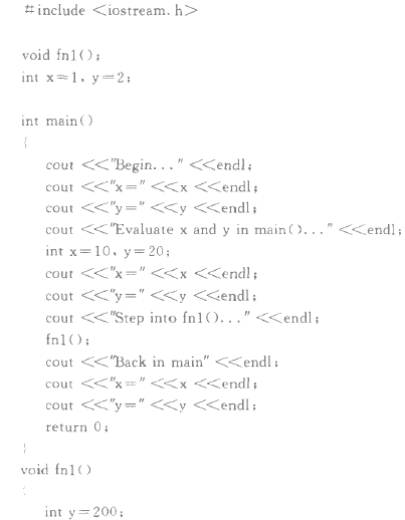C++面向对象 实验报告
实验一类与对象
一、 实验目的
1、 掌握类的声明和使用。
2、 掌握类的声明和对象的声明。
3、 复习具有不同访问属性的成员的访问方式。
4、 观察构造函数和析构函数的执行过程。
5、 学习类的组合使用方法。
6、 使用VC++的debug调试功能观察程序流程,跟踪观察类的构造函数、析构函数、成员函数的执行顺序。
二、 实验任务
1、 声明一个CPU类,包含等级(rank)、频率(frequency)、电压(voltage)等属性,有两个公有成员函数run、stop。其中,rank为枚举类型CPU_Rank,声明为enum CPU_Rank{P1=1,P2,P3,P4,P5,P6,P7},frequency为单位是MHz的整型数,voltage为浮点型的电压值。观察构造函数和析构函数的调用顺序。
2、 声明一个简单的Computer类,有数据成员芯片(cpu)、内存(ram)、光驱(cdrom)等等,有两个公有成员函数run、stop。cpu为CPU类的一个对象,ram为RAM类的一个对象,cdrom为CDROM类的一个对象,声明并实现这个类。
3、 (选作)设计一个用于人事管理的People(人员)类。考虑到通用性,这里只抽象出所有类型人员都具有的属性:number(编号)、sex(性别)、birthday(出生日期)、id(身份证号)等等。其中“出生日期”声明为一个“日期”类内嵌子对象。用成员函数实现对人员信息的录入和显示。要求包括:构造函数和析构函数、拷贝构造函数、内联成员函数、组合。
1、#include <iostream>
using namespace std;
enum CPU_Rank {p1=1,p2,p3,p4,p5,p6,p7};
class CPU
{ private:
CPU_Rank rank;
int freauency;
float voltage;
public:
CPU(CPU_Rank r, int f,float v)
{ rank=r;
freauency=f;
voltage=v;
cout<<" This is CPU construct program"<<endl;}
~CPU()
{cout<<" This is CPU destroy function"<<endl;}
void run(){cout<< " The CPU is running"<<endl;}
void stop(){cout<< " The CPU is Stopping"<<endl;}
};
int main()
{
enum CPU_Rank rank;
rank=p5;
CPU cpu1(rank,1024,3.6);
cpu1.run();
cpu1.stop();
return 0;
}
运行结果:This is CPU construct program
The CPU is running
The CPU is Stopping
This is CPU destroy function
2、#include <iostream>
using namespace std;
enum CPU_Rank {p1=1,p2,p3,p4,p5,p6,p7};
class CPU
{private:
CPU_Rank rank;
int freauency;
float voltage;
public:
CPU(CPU_Rank r=p1,int f=0,float v=0)
{ rank=r;
freauency=f;
voltage=v;
cout<<" This is CPU construct program"<<endl;}
~CPU()
{cout<<" This is CPU destroy function"<<endl;}
void run(){cout<<" The CPU is running"<<endl;}
void stop(){cout<<" The CPU is Stopping"<<endl;}
};
class RAM
{private:
int rank;
int size;
public:
RAM( int r=0, int s=0)
{ rank=r;
size=s;}
void run(){cout<<" The RAM is running"<<endl;}
void stop(){cout<<" The RAM is Stopping"<<endl;}
};
class CDROM
{ private:
int rank;
int size;
public:
CDROM ( int r=0, int s=0)
{ rank=r;
size=s;}
void run(){cout<<" The CDROM is running"<<endl;}
void stop(){cout<<" The CDROM is Stopping"<<endl;}
};
class Computer
{
private:
CPU cpu;
RAM ram;
CDROM cdrom;
public:
Computer(CPU c,RAM r,CDROM cd)
{ cout<<" This is the Computer Construct"<<endl;
cpu=c;
ram=r;
cdrom=cd;}
void run()
{ cout<<" This is Computer is running"<<endl;
cpu.run();
ram.run();}
void stop ()
{ cout<<" This is Computer is stop"<<endl;
cpu.stop();
ram.stop();}
};
int main()
{ enum CPU_Rank rank;
rank=p5;
CPU cpu1(rank,1024,3.6f);
RAM ram(5,1024);
CDROM cdrom(5,1024);
Computer cp(cpu1,ram,cdrom);
cp.run();
cp.stop();
return 0;
}
实验二 C++程序结构
1、 实验目的
1. 观察程序运行中的变量的作用域、生存期和可见性。
2. 学习类的静态成员的使用。
3. 学习多文件结构在C++程序中的使用。
2、 实验任务
1. 运行下面程序,2. 观察变量x、y的值。
//lab2_1.cpp


3. 实现客户机(CLIENT)类。定义字符型静态数据成员ServerName,4. 保存其服5. 务器名6. 称:整型静态数据成员ClientNum,7. 记录已定义的客户数量;定义静态函数ChangeServerName()改变服8. 务器名9. 称。在头文件client.h中定义类,10. 在文件client.cpp中实现,11. 在文件test.cpp中测试这个类,12. 观察相应的成员变量取值的变化情况。
实验二 C++程序结构
1、 实验目的
1. 观察程序运行中的变量的作用域、生存期和可见性。
2. 学习类的静态成员的使用。
3. 学习多文件结构在C++程序中的使用。
2、 实验任务
1. 运行下面程序,2. 观察变量x、y的值。
3. 实现客户机(CLIENT)类。定义字符型静态数据成员ServerName,4. 保存其服务器名称:整型静态数据成员ClientNum,记录已定义的客户数量;定义静态函数ChangeServerName()改变服务器名称。在头文件client.h中定义类,在文件client.cpp中实现,在文件test.cpp中测试这个类,观察相应的成员变量取值的变化情况。
三、实验结果
1.
2. 服务器名称为:N
客户机数量为:2
服务器名称为:A
实验源代码:
1.#include <iostream>
using namespace std;
void fn1();
int x = 1, y = 2;
void main()
{
cout << "Begin..." << endl;
cout << "x = " << x << endl;
cout << "y = " << y << endl;
cout << "Evaluate x and y in main()..." << endl;
int x = 10, y = 20;
cout << "x = " << x << endl;
cout << "y = " << y << endl;
cout << "Step into fn1()..." << endl;
fn1();
cout << "Back in main" << endl;
cout << "x = " << x << endl;
cout << "y = " << y << endl;
return 0;
}
void fn1()
{
int y = 200;
cout << "x = " << x << endl;
cout << "y = " << y << endl;
}
2. //client.h
#include <iostream>
#include <string>
using namespace std;
class CLIENT
{
private:
static char ServerName;
static int ClientNum;
public:
CLIENT();
~CLIENT();
static int GetClientNum();
static void ChangServerName(char name);
static char GetServerName();
};
//client.cpp
#include "client.h"
CLIENT::CLIENT()
{
ClientNum++ ;
}
CLIENT::~CLIENT()
{
ClientNum-- ;
}
int CLIENT::GetClientNum()
{
return ClientNum;
}
void CLIENT::ChangServerName(char name)
{
ServerName=name;
}
char CLIENT::GetServerName()
{
return ServerName;
}
//test.cpp
#include <iostream.h>
#include "client.h"
int CLIENT::ClientNum = 0;
char CLIENT::ServerName= 'N';
int main()
{
CLIENT a;
CLIENT b;
cout << "服务器名称为:" << CLIENT::GetServerName() << endl;
CLIENT::ChangServerName('A');
cout << "客户机数量为:" << CLIENT::GetClientNum() << endl;
cout << "服务器名称为:" << CLIENT::GetServerName() << endl;
}
实验三 数组与指针
一、实验目的
1、学习使用数组。
2、学习字符串数据的组织和处理。
3、掌握指针的使用方法。
4、练习通过debug观察指针的内容及其所指的对象的内容。
5、练习通过动态内存分配实现动态数组,并体会指针在其中的作用。
二、实验任务
1、测试3X3矩阵转置函数的程序,程序如下:
#include <iostream>
using namespace std;
void move (int matrix[3][3])
{
int i, j, k;
for(i=0; i<3; i++)
for (j=0; j<i; j++)
{
k = matrix[i][j];
matrix[i][j] = matrix[j][i];
matrix[j][i] = k;
}
}
int main()
{
int i, j;
int data[3][3];
cout << "输入矩阵的元素" << endl;
for(i=0; i<3; i++)
for (j=0; j<3; j++)
{
cout << "第" << i+1 << "行第" << j+1
<<"个元素为:";
cin >> data[i][j];
}
cout << "输入的矩阵的为:" << endl;
for(i=0; i<3; i++)
{
for (j=0; j<3; j++)
cout << data[i][j] << " ";
cout << endl;
}
move(data);
cout << "转置后的矩阵的为:" << endl;
for(i=0; i<3; i++)
{
for (j=0; j<3; j++)
cout << data[i][j] << " ";
cout << endl;
}
}
2、使用动态内存分配生成动态数组来重新设计一个3X3矩阵转置函数,使用指针实现函数的功能。
3、编程实现两字符串的连接。要求使用字符数组保存字符串,不要使用系统函数。
4、使用String类定义字符串对象,重新实现上一小题。
(选作)5、定义一个Employee类,其中包括姓名、街道地址、城市和邮编等属性,以及change_name( )和display()等函数。display()显示姓名、街道地址、城市和邮编等属性,change_name()改变对象的姓名属性。实现并测试这个类。(提示:对字符数组的赋值可以使用字符串拷贝函数strcpy(char *,char*,name))。
(选作)6、定义包含个5元素的对象数组,每个元素都是Employee类型的对象。
实验四 继承与派生
一、实验目的
1、学习定义和使用类的继承关系,定义派生类。
2、熟悉不同继承方式下对基类成员的访问控制。
3、学习利用虚基类解决二义性问题。
二、实验任务
1、定义一个基类Animal,有私有整型成员变量age,构造其派生类dog,在其成员函数SetAge(int n)中直接给age赋值,看看会有什么问题,把age改为公有成员变量,还会有问题吗?编程试试看。
2、定义一个基类BaseClass,有整型成员变量Number,构造其派生类DerivedClass,观察构造函数和析构函数的执行情况。
3、定义一个车(vehicle )基类,具有MaxSpeed、Weight等成员变量,Run,Stop等成员函数,由此派生出自行车(bicycle )类、汽车(motorcar)类,自行车类具有高度(Height)等属性,汽车类有座位数(SeatNum)等属性。从bicycle和motorcar类派生出摩托车(motorcycle )类,在继承过程中,注意把vehicle设置为虚基类。如果不把设置为虚基类,会有什么问题?编程试试看。
实验结果:
1、error C2248: 'age' : cannot access private member declared in class 'Animal'
改正方案:将Animal类中私有成员age换成公共成员。
2、构造基类对象!
构造派生类对象!
析构派生类对象!
析构基类对象!
3、Now it is running!
Now it has stopped!
//如果vehicle不是虚基类,有错误:
error C2385: 'motorcycle::Run' is ambiguous
……
源程序:
1、#include <iostream>
using namespace std;
class Animal
{
private:
int age;
public:
Animal(){};
~Animal(){};
};
class Dog : private Animal
{
public:
Dog(){};
~Dog(){};
void SetAge(int n){ age = n;}
};
int main()
{
Dog a;
a.SetAge(10);
return 0;
}
2、#include <iostream>
using namespace std;
class BaseClass
{
public:
BaseClass() { cout << "构造基类对象!" << endl;}
~BaseClass() { cout << "析构基类对象!" << endl;}
};
class DerivedClass : public BaseClass
{
public:
DerivedClass() {cout << "构造派生类对象!" << endl;}
~DerivedClass() {cout << "析构派生类对象!" << endl;}
};
int main()
{
DerivedClass d;
}
3、nclude <iostream>
using namespace std;
class vehicle
{
private:
int MaxSpeed;
int Weight;
public:
vehicle(){MaxSpeed=0; Weight=0;};
~vehicle(){};
void Run() {cout << "Now it is running!" << endl; }
void Stop() {cout << "Now it has stopped!" << endl; }
};
class bicycle : virtual public vehicle
{
private:
int Height;
public:
bicycle(){};
~bicycle(){};
};
class motorcar : virtual public vehicle
{
private:
int SeatNum;
public:
motorcar(){};
~motorcar(){};
};
class motorcycle : public bicycle , public motorcar
{
public:
motorcycle (){};
~motorcycle (){};
};
int main()
{
motorcycle a;
a.Run();
a.Stop();
}
-
面向对象实验报告
昆明理工大学信息工程与自动化学院学生实验报告20xx20xx学年第1学期课程名称面向对象建模技术开课实验室信自楼44420xx年1…
-
c++面向对象实验报告
广东工业大学实验报告班成绩评定学号姓名合作者号教师签名实验二题目类与对象第12周星期四一实验目的1掌握声明类的方法类和类的成员的概…
-
面向对象程序设计实验报告
综合实验报告面向对象程序设计专业名称班级姓名学号信息科学与工程学院二零一三年七月信息科学与工程学院面向对象程序设计综合实验报告目录…
-
面向对象程序设计实验报告
面向对象程序设计之课程设计上海电力学院课题名称院系专业学号姓名时间地点指导教师课程设计报告面向对象程序设计20xx20xx学年第一…
-
《面向对象分析与设计》实验报告
面向对象分析与设计实验报告计科083班季程08083387实验一用例图一实验目的1学会分析系统中的参与者和用例2掌握用例图的绘制方…
-
售后部年终总结及计划 (1)
4S店售后部年终总结及计划以下四点第一,回顾20xx年度售后服务部的主要工作。第二、三个关键内容——业绩、问题和改善计划缺一不可,…
-
科研技能训练总结
学校:河北科技师范学院欧美学院系别:机电科学与工程系专业:电气工程及其自动化姓名:张承学号:姓名:张承河北科技师范学院欧美学院机电…
-
创建学习型家庭工作总结
根据《xxx学习型家庭创建工作实施意见》,开展以倡导终身学习理念为核心的学习型家庭创建,组织形式多样的群众性学习活动,进一步营造崇…
-
妇产科主任晋升副高职称工作总结
孙**,女,46岁,主治妇幼医师,任保健科、妇产科主任。19xx年x月从**地区卫生学校毕业,分配到**镇卫生院工作,先后在外科室…
-
保险营销人员年终总结发言313
保险营销经理年终总结发言各位领导、各位同仁,大家好!20xx年在公司领导的亲切关怀和其同仁的热情帮助下,和全司员工一起共同努力,较…